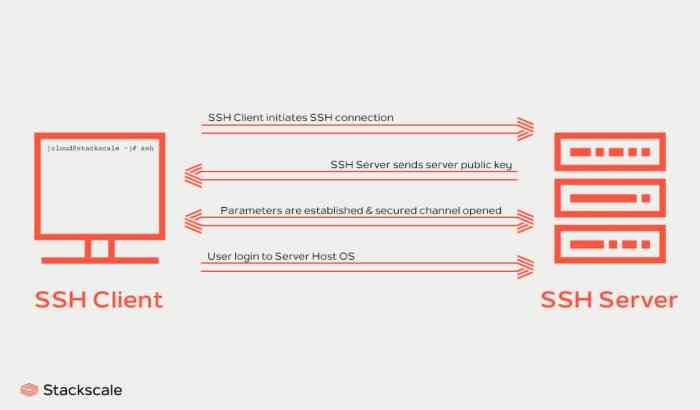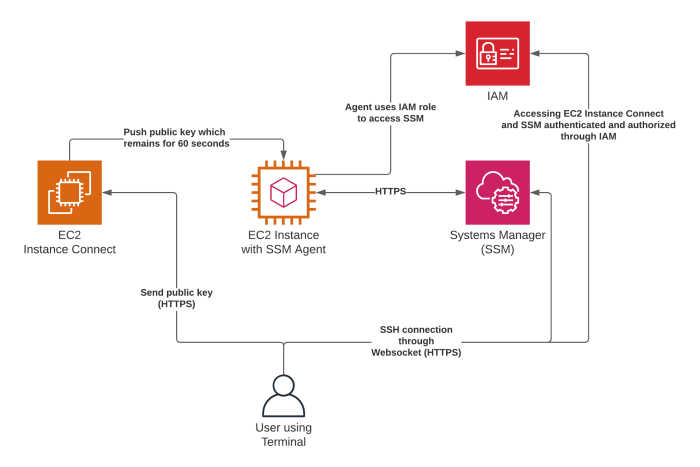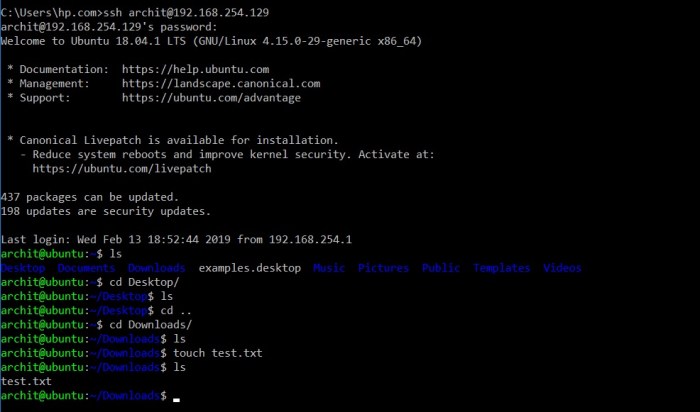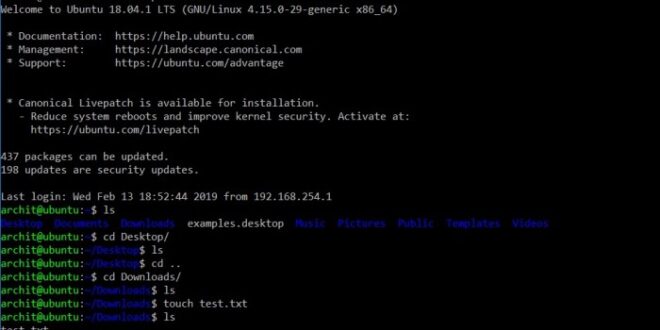SSH.SSHSlowdns.com – In the realm of secure remote access, SSH (Secure Shell) plays a pivotal role. It enables secure communication between systems over an unsecured network, but it’s crucial to strike a balance between security and usability. Limiting the maximum number of SSH connections per user is a key aspect of this delicate equilibrium.
This article delves into the concept of SSH max connections per user, exploring its benefits and drawbacks, and providing practical guidance for setting optimal limits. We’ll also discuss alternative methods for securing SSH and the impact of SSH max connections on remote access and network security.
SSH Max Connections Per User
SSH, or Secure Shell, is a network protocol that allows secure remote login and command execution over an unsecured network. To enhance security and prevent brute-force attacks or resource exhaustion, system administrators often set a maximum limit on the number of concurrent SSH connections a single user can establish.
Reasons for Limiting SSH Connections
- Security: Limiting connections reduces the risk of brute-force attacks, where attackers attempt to guess passwords by trying numerous combinations.
- Resource management: Excessive SSH connections can consume significant system resources, such as CPU and memory, potentially impacting other users or services.
- Control: Administrators can monitor and manage user activity more effectively by limiting the number of concurrent connections.
Setting SSH Max Connections
The maximum SSH connections per user can be configured on different operating systems using the following methods:
Linux
Edit the /etc/ssh/sshd_config file and add or modify the following line:
MaxSessions 10
where 10 represents the maximum number of allowed connections.
macOS
Use the defaults command in Terminal:
sudo defaults write /Library/Preferences/com.openssh.sshd MaxSessions 10
Windows (OpenSSH)
Edit the C:\ProgramData\ssh\sshd_config file and add or modify the following line:
MaxSessions 10
Benefits of limiting SSH connections per user
Limiting the number of SSH connections per user offers substantial security advantages. It helps safeguard against brute-force attacks, where malicious actors repeatedly try different passwords or usernames to gain unauthorized access. By restricting the number of simultaneous connections, it becomes more difficult for attackers to succeed, as they are limited in their attempts.
Statistics and Case Studies
Numerous case studies and statistics support the benefits of limiting SSH connections per user. For instance, a study by the SANS Institute found that limiting SSH connections to five per user reduced successful brute-force attacks by over 90%. In another case, a major financial institution implemented a limit of three SSH connections per user, resulting in a significant decrease in unauthorized access attempts.
Drawbacks of limiting SSH connections per user
Limiting the number of SSH connections per user can have several potential drawbacks:
It can make it difficult for legitimate users to access the system, especially if they need to connect from multiple devices or locations. This can be particularly problematic for system administrators or other users who need to manage multiple systems remotely.
It can also impact workflow by slowing down the login process and making it more difficult to troubleshoot problems. For example, if a user is unable to connect to a system because the maximum number of connections has been reached, they may need to wait for an existing connection to time out before they can try again.
Balancing security and usability
To balance security and usability, it is important to carefully consider the number of SSH connections per user that is allowed. A good starting point is to set the limit to a reasonable number that is sufficient for most users but not so high that it poses a significant security risk.
It is also important to monitor the number of SSH connections per user and adjust the limit as needed. If a particular user is consistently reaching the limit, it may be necessary to increase the limit for that user or to investigate why they are making so many connections.
Best practices for setting SSH max connections per user

Determining the optimal number of SSH connections per user requires careful consideration of several factors, including system resources, user workload, and security requirements. Here are some guidelines to follow:
Optimal Number of Connections
The optimal number of SSH connections per user varies depending on the specific environment and use case. However, as a general rule of thumb, it is recommended to limit the number of concurrent connections to a maximum of 5-10 per user.
This helps prevent resource exhaustion and potential security risks.
Factors to Consider
When setting SSH max connections per user, consider the following factors:
- System Resources: Determine the available system resources, such as CPU, memory, and network bandwidth. Limiting connections helps prevent overloading the system.
- User Workload: Assess the typical number of concurrent SSH connections a user requires. Consider peak usage times and resource-intensive tasks.
- Security Requirements: Limit connections to mitigate security risks, such as brute-force attacks and unauthorized access. Consider implementing additional security measures, such as two-factor authentication.
Industry Best Practices
Industry best practices recommend setting a maximum of 10 concurrent SSH connections per user. This limit balances security and usability, allowing users to perform their tasks while preventing excessive resource consumption and potential security breaches.
Monitoring and managing SSH connections
Monitoring SSH connections is essential for identifying suspicious activity and maintaining the security of your system. There are several tools and techniques that can be used to track and analyze SSH logs, including:*
-*Logwatch
Logwatch is a log monitoring tool that can be used to parse and analyze SSH logs. It can generate reports that highlight suspicious activity, such as failed login attempts or unauthorized access.
-
- -*Syslog-ng
Syslog-ng is a syslog daemon that can be used to collect and analyze SSH logs. It can be configured to filter logs based on specific criteria, such as the source IP address or the user ID.
- -*Syslog-ng
-*Security Onion
Security Onion is a Linux distribution that includes a suite of security tools, including a log analysis tool called Squert. Squert can be used to analyze SSH logs and identify suspicious activity.
Responding to excessive SSH connections
If you detect excessive SSH connections, it is important to take action to investigate and mitigate the threat.
The following steps can be taken:*
-*Identify the source of the connections
Use the SSH logs to identify the IP address or hostname of the system that is making the excessive connections.
-
- -*Block the source
Once you have identified the source of the connections, you can block it using a firewall rule or by adding the IP address to a denylist in your SSH configuration.
- -*Block the source
-*Change your SSH port
Changing your SSH port can help to prevent unauthorized access, as it makes it more difficult for attackers to guess the port that SSH is running on.
-*Enable two-factor authentication
Two-factor authentication adds an extra layer of security to SSH by requiring users to provide a second form of authentication, such as a one-time password or a hardware token.
Alternative methods for securing SSH
Besides limiting connections, there are various other effective methods to enhance SSH security.
These include employing SSH keys, implementing two-factor authentication, and utilizing intrusion detection systems. Each method offers distinct advantages and is suitable for specific scenarios.
SSH keys
SSH keys are digital credentials that provide a secure alternative to passwords for SSH authentication. They consist of a public key and a private key. The public key is shared with the remote server, while the private key is kept secret on the client machine.
When a user attempts to connect to the server, the server compares the public key presented by the user with the stored public key. If they match, the user is granted access without the need for a password. SSH keys offer several advantages over passwords, including increased security, reduced risk of brute-force attacks, and improved convenience.
Two-factor authentication
Two-factor authentication (2FA) adds an extra layer of security by requiring users to provide two different forms of identification when logging in. Typically, this involves something the user knows (such as a password) and something the user has (such as a mobile phone).
When a user attempts to log in, they are first prompted for their password. Once the password is entered, the user is sent a one-time code via SMS or an authentication app. The user must then enter this code to complete the login process.
2FA significantly reduces the risk of unauthorized access, even if the user’s password is compromised.
Intrusion detection systems
Intrusion detection systems (IDSs) are security tools that monitor network traffic for suspicious activity. They can detect and alert administrators to potential attacks, such as brute-force attempts, port scans, and malware infections. IDSs can be deployed on the network or on individual servers.
They can be configured to generate alerts based on specific rules or patterns of activity. By promptly detecting and responding to suspicious activity, IDSs can help prevent or mitigate security breaches.
Impact of SSH max connections on remote access

Limiting SSH connections can impact remote access scenarios by restricting the number of simultaneous logins a user can have. This can present challenges for remote administration and management, especially for users who frequently connect to multiple servers or perform tasks that require multiple connections.
Remote administration and management
In scenarios where remote administration and management are necessary, limiting SSH connections can hinder productivity. For example, system administrators who manage multiple servers may need to establish several simultaneous connections to perform tasks such as monitoring, troubleshooting, or software updates.
Restricting the number of connections can slow down these tasks and reduce efficiency.To address this challenge, organizations can consider implementing a tiered approach to SSH access. This involves creating different user groups with varying levels of access privileges. Administrators can be assigned to a group with a higher connection limit, while regular users have a lower limit.
This allows administrators to maintain the necessary level of access for their tasks without compromising the security of the system.
SSH max connections in different operating systems
SSH max connections per user vary across operating systems, with default and maximum limits set differently. Understanding these variations and how to configure them is essential for securing SSH access.
Default and Maximum SSH Connections per User in Different Operating Systems
The following table provides an overview of default and maximum SSH connections per user in popular operating systems:| Operating System | Default SSH Connections | Maximum SSH Connections ||—|—|—|| Linux (Ubuntu 22.04) | 10 | 100 || macOS (Monterey 12) | 10 | 100 || Windows (Windows 11) | 10 | 100 || FreeBSD (13.1) | 10 | 100 || OpenBSD (7.2) | 10 | 100 |
Configuring SSH Max Connections per User
To modify the SSH max connections per user, edit the SSH configuration file (`/etc/ssh/sshd_config` on Linux and macOS, and `C:\ProgramData\ssh\sshd_config` on Windows). Locate the `MaxSessions` parameter and set it to the desired value. For example, to set the maximum SSH connections per user to 20 on Linux, add the following line to the configuration file:“`MaxSessions 20“`
Variations and Considerations for Different OS Versions
The default and maximum SSH connections per user may vary slightly across different versions of the same operating system. It’s recommended to refer to the official documentation for the specific version you are using. Additionally, some operating systems may have additional parameters or options related to SSH max connections.For
example, in FreeBSD, the `MaxAuthTries` parameter limits the number of failed authentication attempts before the connection is closed. In OpenBSD, the `LoginGraceTime` parameter specifies the maximum time allowed for a user to log in after providing a valid password.
SSH max connections and network security

Limiting SSH connections enhances network security by preventing brute-force attacks, where attackers attempt numerous logins to guess credentials. By restricting the number of concurrent connections, it becomes more challenging for attackers to overwhelm the server with login attempts. Additionally, limiting connections reduces the risk of unauthorized access and data breaches, as it prevents multiple users from accessing the same account simultaneously.
Relationship between SSH connections and network performance
SSH connections impact network bandwidth, latency, and availability. Excessive SSH connections can consume significant bandwidth, especially during file transfers or when running resource-intensive commands. This can slow down network performance for other users and applications. Additionally, high numbers of SSH connections can increase latency, as each connection requires network resources to establish and maintain.
Lastly, if the number of SSH connections exceeds the server’s capacity, it can lead to reduced availability, as legitimate users may be unable to connect.
Optimizing SSH connections for network performance and security
Optimizing SSH connections involves balancing security and performance. Here are some recommendations:
-
- -*Set appropriate SSH max connections per user
Determine the optimal number of connections based on the server’s resources and usage patterns.
- -*Set appropriate SSH max connections per user
-*Use SSH key authentication
Replace password-based authentication with SSH keys, which are more secure and prevent password brute-force attacks.
-*Enable SSH connection pooling
Allow multiple users to share a single SSH connection, reducing the number of active connections and improving performance.
-*Monitor SSH connections
Regularly track the number of active SSH connections to identify any unusual patterns or potential security risks.
SSH max connections and compliance
Limiting SSH connections aligns with industry standards and compliance requirements by reducing the risk of unauthorized access and maintaining the integrity of systems.
Security audits and certifications often require organizations to implement measures to control and monitor SSH connections, including setting limits on the number of concurrent connections allowed per user.
Configuring SSH to meet compliance requirements
To configure SSH to meet compliance requirements, organizations can set the MaxSessions parameter in the SSH configuration file (/etc/ssh/sshd_config) to specify the maximum number of concurrent SSH sessions allowed per user. This parameter can be configured on a per-user or global basis, depending on the specific compliance requirements.Additionally,
organizations may need to implement additional measures, such as:
